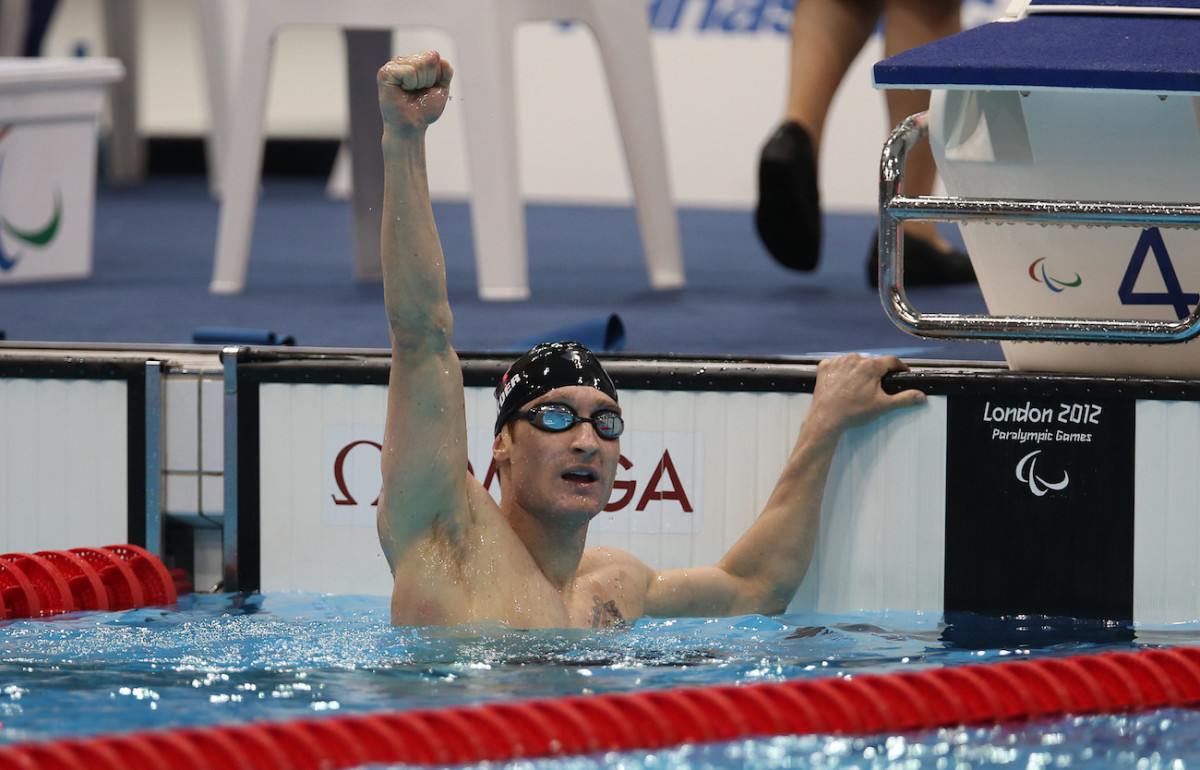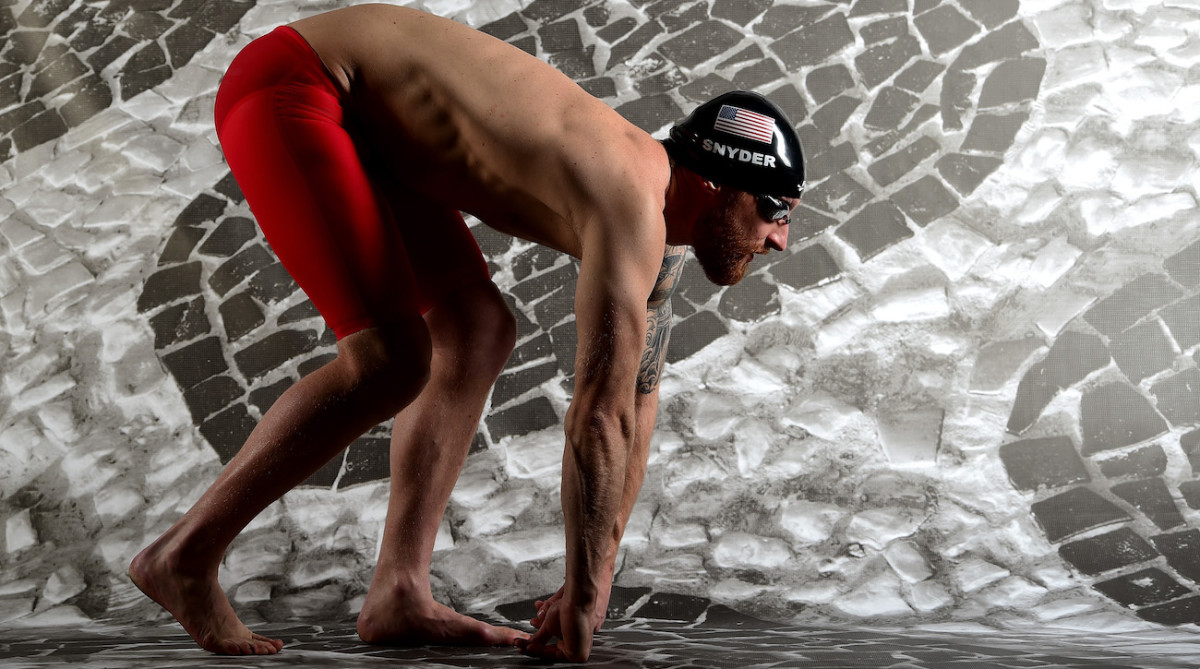Meet Team USA: Brad Snyder, Paralympic Swimming

Brad Snyder is a competitive guy. Whether it was in the pool or at the Naval Academy, Snyder was driven to be the best — and he trained hard to accomplish that goal. He served in the Navy for seven years, earned a commission as a bomb disposal officer, and did tours of duty in Iraq and Afghanistan. But in 2011, six months into his time in Afghanistan, an improvised explosive device (IED) exploded in front of him. He escaped with all his limbs, but he lost his eyesight. His life was changed forever.
During his recovery, he had a “chip on my shoulder,” Synder remembers. But he didn’t want people to feel sorry for him. So he did what he always had: persevere. He pushed himself hard to recover and establish a new normal. And that eventually meant joining Team USA as a Paralympic swimmer. Nearly a year after the explosion that robbed him of his sight, Snyder found himself competing in the 2012 Paralympic Games in London. He won two golds (100m and 400m Freestyle) and a silver (50m Freestyle) and became an instant swimming star. This month, the 32-year-old will look to add to his collection at the 2016 Paralympics, which are held in Rio September 7-18.
Sports Illustrated Kids spoke with Snyder at the Summer Olympics media event in New York City in April. He shared his experiences, both in the pool and out, explained the differences between Paralympic and able-bodied swimming, and gave advice for kids who want to play sports but might be disabled.
How has training been so far?
Training this go-around is awesome. Under Armour is one of my partners, and they have allowed me to work out at their facilities [with] an NFL-style trainer two or three days a week. So my strength training is awesome. I work out at that same facility with other athletes like Randall Cobb and Cam Newton. Working out alongside other professional athletes who are at the top of their game really inspires me, and I feel like I’m the strongest I’ve ever been. In my able-bodied career, I was a distance swimmer, moved into triathlon. My races were an hour, two hours, sometimes [longer]. To swim a race that’s 25 seconds, that’s a far cry from what I’m used to. Translating what I’ve done in the endurance space down into the power space has been a challenge, but for the first time I feel like I’m comfortable sprinting and I’m really excited about taking a new powerful Brad into the Rio Games.
What was the biggest transition for going from an able-bodied swimmer to Paralympic swimming?
I think tactically there’s small adaptions you make in the pool where someone puts a tennis ball on the end of a cane and they tap me as I’m getting close to the wall. I changed my stroke where I’m dragging the surface of the water looking for the lane line. So small tactical changes [like that]. I think the biggest thing is more, like, just living blind is a huge challenge. How do I get to the grocery store? How do I get to training? How do I find a place where I can get to consistently without having to wear out favors on my family? Suff like that. It’s taken me three years, but I’ve built an infrastructure living in Baltimore where I train at Under Armour and I work out at Loyola University and I have a friend who trains with me who lives at my house that I ride with. I think the biggest challenge and the biggest transition for me was building an infrastructure around myself to allow me to train at an optimal level.

From a spectator perspective, is Paralympic swimming any different from able-bodied swimming?
Yeah. It’s unfortunately kind of confusing when you first look at it because there’s 14 different disability classifications, 1 through 10 being physical disabilities ranging from 1 being the most severe to 10 being the least severe. And there’s three different visually impaired categories: 11, 12 and 13. Eleven, what I am, is completely blind; 12 is severely visually impaired; and 13 is legally blind. And 14 is cognitive disabilities. Any given race, it’s not like purely the fastest man in the pool wins. It’s the fastest S-10, the fastest S-9, the fastest S-8. And so from a spectator’s point of view, it’s a little bit complex when you get into that. And then also there’s the tapping dynamic. When you watch blind swimmers all getting wacked by people on the side of the pool you’re thinking, “What’s going on there?” Once you get versed in the classification system though, it’s back to kind of the same race you’re used to. Eight swimmers dive off, the fastest one to the wall wins. And that’s something we all can get behind.
Can I ask you about how you lost your sight?
I actually had a whole previous life [prior] to being in the Paralympics. I went to the Naval Academy, earned a commission in 2006, spent about 7 years in the Navy as a bomb disposal officer, so I was a bomb squad guy. Deployed to Iraq and Afghanistan. Unfortunately, after six months of combat operations in Afghanistan, I stepped on an improvised explosive device that blew up about a foot and a half in front of me. The blast came out of the ground, hit me in the face, took away my vision. But thankfully came away with all 10 fingers, 10 toes.
I had a chip on my shoulder when I was first in the hospital. I didn’t want people to feel sorry for me. I didn’t want to be a victim. I needed a way to show people that I’m going to charge forward and find a way to get back into life, and the Paralympics were there for me as an opportunity to do that. Pretty rapidly repurposed my life, hung up my naval uniform and joined Team USA pretty much right away, and within a year I actually won a gold medal at the [2012] London Games. So now I’ve built a career around swimming and representing my corporate partners and it’s been awesome. So it’s funny to be at 32, having made a career change into professional athletics after kind of hanging up my Speedo in 2006 after a collegiate career, thinking I’d never get back into swimming. And here I am. Life takes you in funky directions sometimes.
How did swimming help you in your recovery?
For me, one of the biggest things that was difficult about being blind was not the loss of my vision — it was like that loss of my vocation. I built this career. I was really good at the job I did. I deployed around the world making the world a safer place by getting rid of bombs in the ground and stuff. Having that purpose taken away was the hardest thing for me. What I had to do is, I had to reinvent that purpose… re-identify that purpose, not reinvent. I’m a leader, right? Like, I was a leader in the Navy, I want to be a leader in the community. And now what I do as a Para-athlete, it’s more than just swimming across the pool really fast. I’m representing an idea where we can change the perception of what disability means. So when people see me succeed in the Paralympics, they don’t see me struggling with my blind cane. They don’t see me as a charity case. They don’t come over and say, “We’re so sorry for you.” They’re, like, “Woah, that was awesome! Did you see that race?” and “USA beat Russia!” and all that sort of stuff. It changes the way that we perceive disability.
I am a community leader now. My new purpose is changing the perception of disability, inspiring our community to do things they didn’t think they were capable of, giving that 11-year-old, that 12-year-old that dream of joining Team USA and becoming a fencer, a judo athlete or whatever it is. What’s great about the Paralympics is we do that for the entire community regardless of disability or not. So I’m really excited about that re-identified purpose, and that’s the transition that Paralympics allowed me to have. Hang up my uniform, take that job away, but now I’ve got a new job.

Does it mean something more for you as somebody who was in the military to now be representing your country in this different way?
That’s the personal gratification that I get out of it. When I stand on the podium and my flag’s raised, that’s the pinnacle of sports for me. It can’t get any better. And I’ll tell you a quick anecdote:
When I won in London, after I won on the anniversary of the day I lost my vision, I went to the tunnel afterward and a guy came over to me and gave me this beret. I felt the beret, and on it was this really neat crest. I found out a Royal Marine, a Marine in the British Marine Corps, was the one who raised my flag. The forces we have in Afghanistan, it’s a joint war. We fight with British soldiers, with Australian soldiers. He said it was an honor for him to raise a flag for a fellow warrior. I’m a service-minded individual. What I do in the Paralympic realm is for the community. But the personal gratification that I get about winning is raising my flag higher than all the others, and that’s what I’m doing it for. I’m getting teary talking about it because it’s such an emotional… This happened to me at the media summit for the USOC, like, I started crying in an interview. I’m a bearded, tough Navy veteran. I hate crying in front of people. But that’s one moment in my life that stands out as one of those that every time I put myself back in that moment, I get goose bumps. I get choked up. It’s really cool.
What advice would you give to a kid who might be disabled or challenged who wants to do what you and your fellow Olympians do?
Just dream big. There’s no reason to put limits on what you’re capable of. You’ll never know what you’re truly capable of until you put yourself out there and try, right? There is obviously a limit to what I’m capable of, but I’ve lived my entire life predicated on the idea that I’m going to see what those barriers are. I want to jump from really high things. I want to challenge myself. I want to push myself as hard as I can go, and if I fail that only means that I found where that line is. And now I’m going to reiterate… I’m going to find a way to try to make it better. I’m going to train harder, go faster, jump higher, all those sorts of things. So the only limits that we find in life sometimes are mental ones. Don’t put a limit on what you think you’re capable of.
Photos: Harry How/Getty Images (portraits), Ian MacNicol/Getty Images (action)
